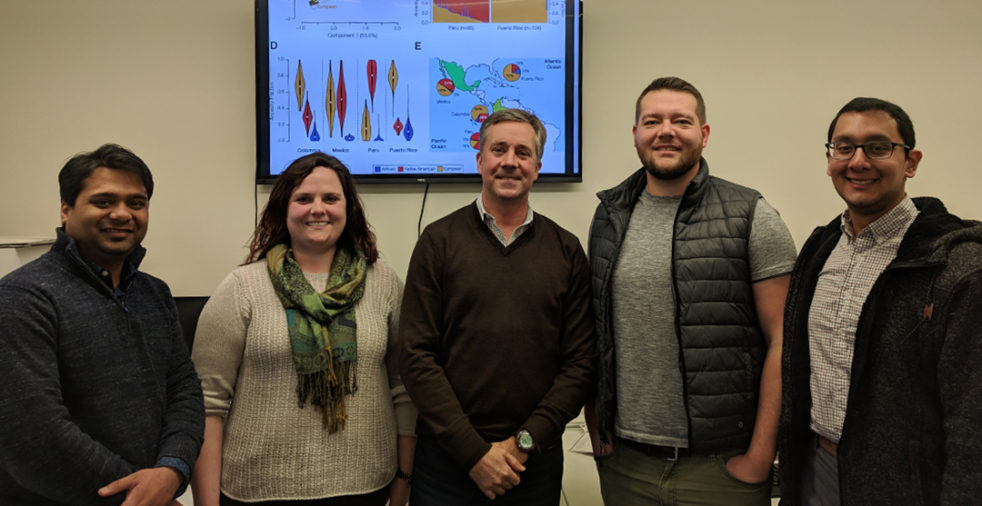In the Jordan Lab at Georgia Tech, Ph.D. candidate Emily Norris is making strides towards understanding how genetic ancestry and admixture influence health outcomes in Latin America.
The Jordan bioinformatics group is broadly interested in the relationship between human genetic ancestry and health, as well as in the diversification of genomics research. Clinical genomics studies in the US are largely conducted on patient cohorts with European ancestry, resulting in a relative dearth of scientific knowledge concerning health determinants in other populations. In the group’s recent paper, they looked at Latin America broadly, and honed in on Colombia specifically.
The narrative of human evolution provides the backdrop for the Jordan group’s work. Over the course of human existence, most changes in the human genome have been gradual and incremental. Humans originated in Africa about 250,000 years ago and subsequently spread to other continents between 100,000 and 75,000 years ago. Over the course of thousands of years, human populations adapted to their local environments and gradually accumulated genetic differences. However, about five hundred years ago, the gradual process of human evolutißon and population divergence was flipped upside down when Europeans landed on the American continent.
Due to European immigration and the ensuing transatlantic slave trade, three distinct ancestral populations — Native Americans, Europeans and Africans — were mixed, a process known as genetic admixture. Norris’ research tests the hypothesis that this genetic admixture stimulated a drastic acceleration of natural selection, with advantageous mutations becoming nearly ubiquitous over a very short timescale. Because the ancestral populations had been physically isolated for so long, they had accumulated genotypic and phenotypic diversity and differed genetically with respect to disease prevalence. When these groups were suddenly and traumatically combined, diseases were exchanged and populations were forced to undergo radical changes to survive. As a result, the New World has become a laboratory for understanding admixture and genetic determinants of health and fitness.
In Latin America, each population can be broken down by percentages into the three ancestral populations. For example, Puerto Rico is 72 percent European, with the other two portions — Native American and African — approximately equal. These percentages should also be reflected in the genome. To check this, Norris looked at millions of variants in the human genome and narrowed them down using a series of analytical steps. In particular, the group studied the most common type of genetic variation among people, single nucleotide polymorphisms (SNPs), pronounced “snips.” Using a technique called “chromosome painting” to indicate which parts of the chromosome come from which ancestries, they were able to identify the SNPs in which certain ancestries were overrepresented. Such SNPs clarify the effect of the relatively rapid natural selection that occurred due to adaptation to the New World environment.
The idea of anomalous ancestry patterns is known as ancestry enrichment. Norris sifted through the human genome to find evidence for ancestry enrichment in genes that produce phenotypes via biological pathways. She analyzed pathways related to disease and health, metabolism and immune response and presented examples of ancestry enrichment from each category. What she saw was that certain pathways for drug metabolism, disease and immune response were enriched in all of the Latin American populations that she studied.
The interpretation of pathway enrichment frequently has to do with how we fight infectious diseases. Often, the reason that genetic variants occur more frequently is that they were helpful somehow in fighting against disease. For example, a variant might affect how genes are expressed in order to better fight a parasite. To quantify how gene expression in certain pathways affect health, the group used a tool called “Expression Quantitative Trait Loci,” or eQTL. What they found is that a number of the genes regulated by ancestry-specific SNPs affected the immune system and infectious disease responses.
The medical potential for genomics research is enormous; however, the current clinical bias in favor of European ancestries will drastically limit the scope of any healthcare improvements. The Jordan Lab hopes that continued genomic studies on underrepresented populations will help advancements in healthcare reach people everywhere.
